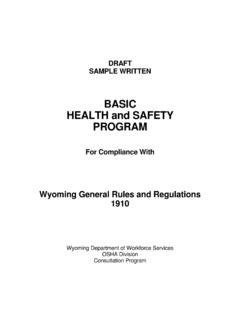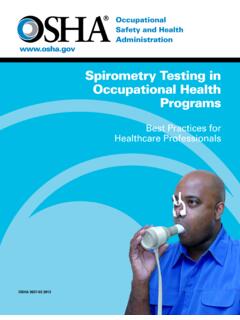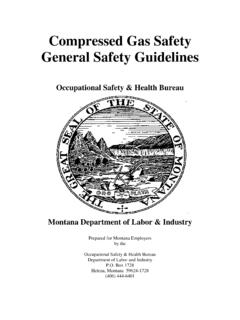Transcription of Laboratory Safety Guidance - Occupational Safety and ...
1 Laboratory SafetyGuidance OSHA 3404-11R 2011 Occupational Safety and health Act of 1970 To assure safe and healthful working conditions for working men and women; by authorizing en-forcement of the standards developed under the Act; by assisting and encouraging the States in their efforts to assure safe and healthful working conditions; by providing for research, information, education, and training in the field of Occupational Safety and health . This publication provides a general overview of a particular standards -related topic. This publication does not alter or determine compliance responsibil-ities which are set forth in OSHA standards , and the Occupational Safety and health Act of 1970. Moreover, because interpretations and enforcement policy may change over time, for additional guid-ance on OSHA compliance requirements, the reader should consult current administrative interpreta-tions and decisions by the Occupational Safety and health Review Commission and the contained in this publication is in the public domain and may be reproduced, fully or partially, without permission.
2 Source credit is requested but not information will be made available to sensory- impaired individuals upon request. Voice phone: (202) 693-1999; teletypewriter (TTY) number: 1-877-889-5627. Laboratory SafetyGuidance Occupational Safety and health Department of LaborOSHA 3404-11R 20112 Occupational Safety and health AdministrationThis Guidance document is not a standard or regulation, and it creates no new legal obligations. It contains recommendations as well as descriptions of mandatory Safety and health standards . The recommendations are advisory in nature, informational in content, and are intended to assist employers in providing a safe and healthful workplace. The Occupational Safety and health Act requires employers to comply with Safety and health standards and regulations promulgated by OSHA or by a state with an OSHA-approved state plan. In addition, the Act s General Duty Clause, Section 5(a)(1), requires employers to provide their employees with a workplace free from recognized hazards likely to cause death or serious physical harm.
3 Laboratory SAFETY3 ContentsIntroduction 4 OSHA standards 5 Hierarchy of Controls 8 Chemical Hazards 9 Laboratory Standard 9 Hazard Communication Standard 13 Specific Chemical Hazards 13 Air Contaminants Standard 13 Formaldehyde Standard 14 Latex 15 Chemical Fume Hoods 15 Biological Hazards 15 Biological Agents (other than Bloodborne Pathogens) and Biological Toxins 15 Bloodborne Pathogens 17 Research Animals 19 Biological Safety Cabinets (BSCs) 21 Physical Hazards and Others 21 Ergonomic Hazards 21 Ionizing Radiation 21 Non-ionizing Radiation 22 Noise 23 Safety Hazards 24 Autoclaves and Sterilizers 24 Centrifuges 24 Compressed Gases 24 Cryogens and Dry Ice 25 Electrical 25 Fire 26 Lockout/Tagout 27 Trips, Slips and Falls 28 References 29 Appendices 30 Additional OSHA Information 30 Other Governmental and Non-governmental Agencies Involved in Laboratory Safety 40 Most Common Zoonotic Diseases in Animal Workers 45 Complaints, Emergencies and Further Assistance 46 OSHA Regional Offices 48 4 Occupational Safety and health AdministrationIntroductionMore than 500,000 workers are employed in lab-oratories in the The Laboratory environment can be a hazardous place to work.
4 Laboratory workers are exposed to numerous potential hazards including chemical, biological, physical and radio-active hazards, as well as musculoskeletal stresses. Laboratory Safety is governed by numerous local, state and federal regulations. Over the years, OSHA has promulgated rules and published Guidance to make laboratories increasingly safe for personnel. This document is intended for supervisors, principal investigators and managers who have the primary responsibility for maintaining laboratories under their supervision as safe, healthy places to work and for ensuring that applicable health , Safety and environmental regulations are followed. Worker Guidance in the form of Fact Sheets and QuickCards is also provided for certain hazards that may be encountered in laboratories. There are several primary OSHA standards that apply to laboratories and these are discussed below. There are also other OSHA standards that apply to vari-ous aspects of Laboratory activities and these are referred to in this document.
5 The Occupational Exposure to Hazardous Chemicals in Laboratories standard (29 CFR ) was created specifically for non-production laboratories. Additional OSHA standards provide rules that protect workers, including those that who in laboratories, from chemical hazards as well as biological, physical and Safety hazards. For those hazards that are not covered by a specific OSHA standard, OSHA often provides Guidance on protecting workers from these hazards. This document is designed to make employers aware of the OSHA standards as well as OSHA Guidance that is available to protect workers from the diverse hazards encountered in laboratories. The extent of detail on specific hazards provided in this document is dependent on the nature of each hazard and its importance in a Laboratory setting. In addition to information on OSHA standards and Guidance that deal with Laboratory hazards, appendices are provided with information on other governmental and non-governmental agencies that deal with various aspects of Laboratory Safety .
6 This Laboratory Safety Guidance booklet deals specifically with laboratories within the jurisdiction of Federal OSHA. There are twenty-five states and two Territories (Puerto Rico and the Virgin Islands) that have their own OSHA-approved Occupational Safety and health standards , which may be different from federal standards , but must be at least as effective as the federal standards . Contact your local or state OSHA office for further information. More information on OSHA-approved state plans is available at: SAFETY5 OSHA StandardsSection 5(a)(1) of the Occupational Safety and health Act of 1970 (OSH Act), the General Duty Clause, requires that employers shall furnish to each of his employees employment and a place of employment which are free from recognized hazards that are causing or likely to cause death or serious physical harm to his employees. Therefore, even if an OSHA standard has not been promulgated that deals with a specific hazard or hazardous operation, protection of workers from all hazards or hazardous operations may be en-forceable under section 5(a)(1) of the OSH Act.
7 For example, best practices that are issued by non-reg-ulatory organizations such as the National Institute for Occupational Safety and health (NIOSH), the Centers for Disease Control and Prevention (CDC), the National Research Council (NRC), and the National Institutes of health (NIH), can be enforce-able under section 5(a)(1). The principal OSHA standards that apply to all non-production laboratories are listed below. Although this is not a comprehensive list, it in-cludes standards that cover the major hazards that workers are most likely to encounter in their daily tasks. Employers must be fully aware of these standards and must implement all aspects of the standards that apply to specific Laboratory work conditions in their Occupational Exposure to Hazardous Chemicals in Laboratories standard (29 CFR ), commonly referred to as the Laboratory standard, requires that the employer designate a Chemical Hygiene Officer and have a written Chemical Hygiene Plan (CHP), and actively verify that it remains effective.
8 The CHP must include provisions for worker training, chemical exposure monitoring where appropriate, medical consultation when exposure occurs, criteria for the use of personal protective equipment (PPE) and engineering controls, special precautions for particularly hazardous substances, and a requirement for a Chemical Hygiene Officer responsible for implementation of the CHP. The CHP must be tailored to reflect the specific chemical hazards present in the Laboratory where it is to be used. Laboratory personnel must receive training regarding the Laboratory standard, the CHP, and other Laboratory Safety practices, including exposure detection, physical and health hazards associated with chemicals, and protective Hazard Communication standard (29 CFR ), sometimes called the HazCom stan-dard, is a set of requirements first issued in 1983 by OSHA. The standard requires evaluating the poten-tial hazards of chemicals, and communicating infor-mation concerning those hazards and appropriate protective measures to employees.
9 The standard includes provisions for: developing and maintaining a written hazard communication program for the workplace, including lists of hazardous chemicals present; labeling of containers of chemicals in the workplace, as well as of containers of chemicals being shipped to other workplaces; preparation and distribution of material Safety data sheets (MSDSs) to workers and downstream employers; and devel-opment and implementation of worker training pro-grams regarding hazards of chemicals and protec-tive measures. This OSHA standard requires manu-facturers and importers of hazardous chemicals to provide material Safety data sheets to users of the chemicals describing potential hazards and other information. They must also attach hazard warning labels to containers of the chemicals. Employers must make MSDSs available to workers. They must also train their workers in the hazards caused by the chemicals workers are exposed to and the appro-priate protective measures that must be used when handling the Bloodborne Pathogens standard (29 CFR ), including changes mandated by the Needlestick Safety and Prevention Act of 2001, re-quires employers to protect workers from infection with human bloodborne pathogens in the workplace.
10 The standard covers all workers with reasonably anticipated exposure to blood or other potentially infectious materials (OPIM). It requires that information and training be provided before the worker begins work that may involve Occupational exposure to bloodborne pathogens, annually thereafter, and before a worker is offered hepatitis B vaccination. The Bloodborne Pathogens standard also requires advance information and training for all workers in research laboratories who handle human immunodeficiency virus (HIV) or hepatitis B virus (HBV). The standard was issued as a performance standard, which means that the employer must develop a written exposure control plan (ECP) to provide a safe and healthy work environment, but is allowed some flexibility in accomplishing this goal. Among other things, the ECP requires employers to make an 6 Occupational Safety and health Administrationexposure determination, establish procedures for evaluating incidents, and determine a schedule for implementing the standard s requirements, including engineering and work practice controls.













